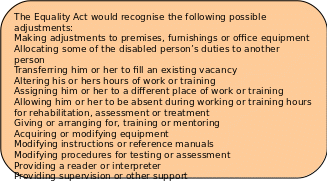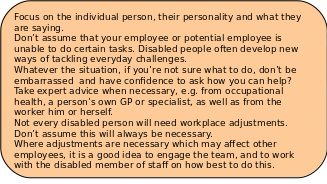GUIDANCE ON DISABILITY AND REASONABLE ADJUSTMENTS INTRODUCTION
UNOFFICIAL FUNDS MANUAL OF GUIDANCE MARCH5 GUIDANCE OFFICE DUE TO ORANGE ROTARY
CARDS EXERCISE FACILITATOR GUIDANCE LEARNING OUTCOME TO GAIN
FORESHORE ACTS 1933 TO 2011 GENERAL GUIDANCE
GENERAL RISK FORM ASSESSMENT GUIDANCE – LABORATORY INTRODUCTION
GUIDANCE FOR THE PLACEMENT OF VOLUNTEERS PLACEMENT OF
ETHNIC MONITORING
Guidance on Disability and Reasonable Adjustments
Introduction
The Equality Act (2010) protects all employees against unfair treatment, discrimination, harassment and victimisation on the grounds of:
Disability or carers associated with disability
Gender, Transgender or Maternity
Ethnicity
Age
Sexual Orientation
Religion/belief
The act recognises in particular the need sometimes to treat people more favourably who may be at risk of unfair treatment, discrimination, harassment or victimisation. This is what is meant by a reasonable adjustment. The Act recognises specifically that reasonable adjustments are required for people who have a disability.
This guidance will focus mainly on Disability, however the act would apply equally to gender, ethnicity, age, sexual orientation, religion and belief, maternity, transgender or ethnicity.
The Equality Act (2010) defines a disability as a long term health condition affecting someone that has had an affect on their ability to carry out normal day-to-day activities. “Long-term” means that it must have lasted, or be expected to last, at least 12 months.

Range of conditions potentially recognised by the Equality Act
The Equality Act (2010) does not simply cover visible disabilities such as the need to use a wheelchair. The definition of disability can cover:
Physical and visible impairments.
Sensory impairment.
Invisible conditions such as epilepsy or diabetes.
Mental illness such as depression or anxiety disorder
Other mental impairment such learning difficulties of dyslexia
Physical illness, whether temporary, permanent or fluctuating.
Temporary injury, such as those caused by an accident at or outside or work.
Temporary incapacity, for example immediately before, during and after an operation.
Almost any condition can be covered by the Equality Act provided it is sufficiently serious and lasts (or will last) at least 12 months.
Social Model of Disability
The social model of disability recognises that many people have impairments; however
it is the social environment that disables them by putting up a number of barriers, including:
Physical access – buildings, information and transport.
Public attitudes that make assumptions about people who have impairments.
The social model is about removing these barriers, so that people with different impairments can play a full part in life.
Myth busting on disability
Disability is not always visible. Many impairments such as epilepsy, dyslexia and diabetes are hidden.
95% of disabled people do not use wheelchairs.
Adjustments made for disabled employees can benefit other employees as well as customers.
Retaining an employee who becomes disabled makes use of skills and knowledge already in place.
Disabled employees have a strong commitment to work, as well as good punctuality, low absences and are more likely to stay in the job.
The major barrier people with mental health problems face are attitudinal rather than physical.
Why disclose a disability?
It is really important that disabled employees feel they can declare. Benefits of monitoring disability in the workforce include:
Better understanding of the needs of the workforce.
Promoting a culture of inclusion, and challenging stigma.
Helps in long term planning around access.
However, employees are often reluctant to declare, because they are afraid of experiencing discrimination. This is particularly true for people with conditions which attract prejudicial attitudes, such as HIV or mental health problems.
Employers’ duties
The most important part of the law against disability discrimination is the duty on employers to make reasonable adjustments. Basically this means employers must take reasonable steps, so that the worker can carry out his or her job.
Employers tend to think that adjustments are likely to be expensive and inconvenient. Research indicates that this is not true.

Many cases have been heard by tribunals so there are lots of decisions to look back on for interpretation and guidance on the scope and meaning of duties and requirements.
What are Reasonable Adjustments?
The concept of reasonable adjustments is based on the social model of disability. It recognises that small adjustments to a person’s working life can make all the difference between whether a person can stay in employment.

Many adjustments are common sense and can be implemented very simply and cost-effectively. Others need more consideration.
Responsibility of staff and managers
It is the responsibility of the member of staff to let their manager know if they require a reasonable adjustment. The line manager is then responsible for taking action in response to the request. Managers are expected to act positively and constructively.
This does not mean that either the staff member or the manager have to be an expert on their condition.
In some cases it will be easy to identify the reasonable adjustment, though in other cases, they may need more expert advice.
The manager has a right to decide if a request is reasonable, and can seek advice from the Corporate Equality Team on the policy of reasonable adjustments, if they are not sure.
When deciding whether or not an adjustment is reasonable a manager should consider:

Where there is a cost to the reasonable adjustment, the employer can expect to incur some of the costs. How much an employer should spend depends on the size of the organisation (larger employers with substantial resources are expected to do more) and whether grants are available.
Access to Work Scheme (Department of Work and Pensions)
Access to work is a government run programme delivered by Jobcentre Plus to help overcome barriers that disabled people come across on getting or keeping work.
Access to Work can provide a grant towards additional employment costs resulting from an employee’s disability that an employer would not normally be expected to provide. To be eligible for Access to Work the applicant must be:
In a paid job
Unemployed and about to start a job
Unemployed and about to start a work trial
Self-employed
On permitted work.
The person’s disability or health condition must stop them from being able to do parts of their job, and this must be likely to last for 12 months or more.
Access to Work can pay towards specialist equipment an employee needs, adapting premises to meet their needs, or a support worker. It can also pay towards the cost of getting to and from work if the employee is unable to use public transport.
If an employee is eligible for support under the Access to Work programme, they will need to submit an application. Applications are taken by telephone.
Access to work will pay a proportion of the costs of support if all of the following applies:
The employee has been in the job for six weeks or more
The employee needs special equipment or adaptations to premises.
The precise level of cost sharing between an employer and Access to Work varies in relation to the number of employees the employer has. For a large employer with over 250 employees, the employer share of the cost will be the first £1000 and 20% of costs up to £10,000.
Access to Work will review the employee’s circumstances and the support they are receiving on an annual basis.
Tips for best practice
Many disabled people face discrimination through misinformation, misunderstanding, ignorance and fear.

Employers lose good employees and potential employees due to their lack of knowledge about disability and its impact in the workplace.
Key contacts on the application of this policy:
The following people can advise on this policy:
Corporate/Chief Executive: Joel Rasbash, [email protected] 01228 226639
Adults and Local Services: Susan Renucci, [email protected] 01228 221554
Children’s Services: Allyson Carty, [email protected]
Fire and Rescue Service: Suzanne Pender, [email protected] 01539 722627
If you are planning to make a reasonable adjustment you will need to contact your Directorate Human Resources Team
GUIDANCE ON DISABILITY AND REASONABLE ADJUSTMENTS INTRODUCTION
HEALTH AND SAFETY – GUIDANCE SHEET GS2
INCLUSIVE EDUCATION AND LEARNING POLICY GUIDANCE IMPLEMENTATION
Tags: adjustments =================================================, reasonable adjustments, adjustments, disability, introduction, guidance, reasonable
- REGULAMIN KONKURSU „WIELKANOCNA PISANKA’’ INFORMACJE OGÓLNE §1 ORGANIZATOREM KONKURSU
- JORNADA SOBRE EJECUCION CIVIL DENTRO DE LAS ACTIVIDADES DE
- DUYURU ATIKSU ARITMA TESİSİ (AAT) TİP PROJELERİ BAKANLIĞIMIZ ÇEVRE
- ARE YOU A NONTRADITIONAL STUDENT? CHANCES ARE YOU ARE
- A PPENDIX 6 APPENDIX 6 AN ANALYSIS ON THE
- CARTA DE TIEMPO SIGNIFICATIVO LOS MAPAS DE TIEMPO SIGNIFICATIVO
- !DOCTYPE HTML HTML LANGENUS HEAD TITLEVXUNDERGROUNDTITLE META NAMEVIEWPORT CONTENTWIDTHDEVICEWIDTH
- LE SYSTEME COMMUNAUTAIRE D’ECHANGE DE QUOTAS D’EMISSION DE GAZ
- 451 WHAT MISSIONARIES OUGHT TO KNOW… WHAT MISSIONARIES OUGHT
- DATUM 25112020 OBČINA RADEČE ULICA MILANA
- TIPS TO SAFELY HANDLE COOK GROUND BEEF SOURCE SANDRA
- PRIVACY NOTICE – SUMMARY CARE RECORD SALTDAN & ROTTINGDEAN
- GERENCIA REGIONAL DE SALUD ANEXO III TARJETA SALUD CASTELLANOS
- AREA DE COMUNICACIÓN Y PRENSA 7 S ERVICIO DIARIO
- CONVOCATORIA DE AYUDAS DE PROYECTOS DE INVESTIGACIÓN (2005) MEMORIA
- INSTITUTO NACIONAL DE VITIVINICULTURA VITIVINICULTURA RESOLUCIÓN C 42009 IMPLEMÉNTASE
- WALIKOTA PALU PERATURAN DAERAH KOTA PALU NOMOR 2 TAHUN
- ROBERTO ESCOBAR 31922 SED 514 ASSIGNMENT 4 WORD PROCESSING
- DEMANDE DAPPROBATION DUNE MODIFICATION MINEURE DEMANDE D’APPROBATION DUNE MODIFICATION
- JHON RICHARD STRONKS 625 E 18TH STREET HOUSTON TX
- HASHEMITE UNIVERSITY FACULTY OF ENGINEERING MECHANICAL ENGINEERING DEPARTMENT STUDENT
- IOP CONFERENCE SERIES DOI 1010881757899X3161012036 DEEPHAIRCRACKS MECHANISM OF RIGID
- DE CORRESPONDERENDE LEDEN VAN BEVAD LES MEMBRES CORRESPONDANTS DE
- MR VIZSGÁLAT TÁJÉKOZTATÓ ÉS BELEEGYEZŐ NYILATKOZAT NÉV……………………………………………………………………… TAJ SZÁM
- A VERWALTUNGSGEMEINSCHAFT SCHÖNBERG –PASSAMT – 94513 SCHÖNBERG USWEISPASSINHABERIN NAME
- PARTNERSHIPS FOR EALING – LSP EXECUTIVE BOARD DATE 281010
- CANTATA PER A NARRADOR COR INFANTIL A UNA SOLA
- DRAFT 14723 MARCH 2017 INPUT FROM BISC MALMAS THE
- SCTC2018 THE 15TH SPACECRAFT CHARGING TECHNOLOGY CONFERENCE PROGRAMINDEXES PROGRAM
- ONLINE DISCUSSION ON INTEGRATING GENDER EQUALITY IN UNIVERSITIES AND
 RESEARCH ON THE PROVISION OF ASSISTIVE TECHNOLOGY IN IRELAND
RESEARCH ON THE PROVISION OF ASSISTIVE TECHNOLOGY IN IRELAND CONCEPT NOTE QATAR’S THIRD HUMAN DEVELOPMENT REPORT EXPANDING CAPACITIES
CONCEPT NOTE QATAR’S THIRD HUMAN DEVELOPMENT REPORT EXPANDING CAPACITIES WOJNA W HISTORIOGRAFII LITERATURZE KULTURZE I JĘZYKACH EUROPY ŚRODKOWOWSCHODNIEJ
WOJNA W HISTORIOGRAFII LITERATURZE KULTURZE I JĘZYKACH EUROPY ŚRODKOWOWSCHODNIEJ INFORMATION SHEET FOR GUESTS THANK YOU FOR COMPLETING YOUR
INFORMATION SHEET FOR GUESTS THANK YOU FOR COMPLETING YOURSTRATEGIC MANAGEMENT (M390) COURSE DESCRIPTION PETER M MARKULIS PHD
 CONTRACTES MENORS DECLARACIÓ RESPONSABLE REGISTRE GENERAL NÚMENTRADA DATAHORA S
CONTRACTES MENORS DECLARACIÓ RESPONSABLE REGISTRE GENERAL NÚMENTRADA DATAHORA S ESTADÍSTICA DE INVESTIGACIÓN CIENTÍFICA Y DESARROLLO TECNOLÓGICO (I+D) INDICADORES
ESTADÍSTICA DE INVESTIGACIÓN CIENTÍFICA Y DESARROLLO TECNOLÓGICO (I+D) INDICADORESIMPERFECT NOTES THE IMPERFECT TENSE IS ANOTHER WAY OF
THE WORLD IS NOT ENOUGH GOT TO DIE FOR
OFFICIAL HISTORY OF THE CANADIAN FORCES IN THE GREAT
6 KLASIŲ MOKSLEIVIAMS SIŪLOMO ANGLŲ KALBOS MODULIO PROGRAMOS APRAŠAS
UCHWAŁA NR LXXI10532006 RADY MIEJSKIEJ W CZELADZI Z DNIA
 PROCESS FLOW ON HOW TO CHECK RESULT ONLINE 1
PROCESS FLOW ON HOW TO CHECK RESULT ONLINE 1 ÁLGEBRA I 2014 PRÁCTICO Nº 1 NÚMEROS COMPLEJOS 1
ÁLGEBRA I 2014 PRÁCTICO Nº 1 NÚMEROS COMPLEJOS 1BASE READING AMINO ACIDS ARE WHAT PROTEINS ARE MADE
ZAŁĄCZNIK 2 DO UCHWAŁY NR IV442016 RADY GMINY OSIELSKO
SKORO SASVIM OBICNA PRICA SUNCAN LETNJI DANMARKO I ANADRZECI
 RISOTTO AU SAFRAN INGRÉDIENTS 1 ÉCHALOTE
RISOTTO AU SAFRAN INGRÉDIENTS 1 ÉCHALOTE  VALORACIO DE LES JORNADES D’ESTUDI I DE TREBALL PER
VALORACIO DE LES JORNADES D’ESTUDI I DE TREBALL PER PRIJAVA ROKODELSKEGA(SKIH) IZDELKA(OV) ZA PRIDOBITEV PRAVICE DO UPORABE KBZ
PRIJAVA ROKODELSKEGA(SKIH) IZDELKA(OV) ZA PRIDOBITEV PRAVICE DO UPORABE KBZ
